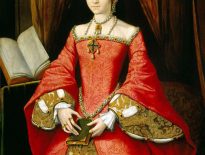On this day in Tudor history, 20th May 1579, wheelwright Matthew Hamont was executed for heresy in the city of Norwich.
What had led to Hamont being charged with heresy? And what exactly was so heretical about his beliefs?
I explain what we know about this little-known Tudor man.
Also on this day in history:
- 1512 – Alain de Chantrezac wrote to M. D'Aumont from Caen regarding a rumour of an English invasion: “Persistent rumour of invasion from England. One who came thence ten days ago says the men are ready but the ships cannot be so till the end of this month. The King will land at Calais, part of his army in Normandy and the rest at Fontarabie. Their 120 or 140 ships seem few for so large an army. The French victory beyond the Mountains and their distrust of Scotland cool the English somewhat; but the young Councillors, by whom the King is ruled, advise this invasion. English ships (15 or 16) have taken a bark of Dieppe and some fishing boats.”
- 1535 – The imprisoned Bishop John Fisher was made a Cardinal by Pope Paul III. It made no difference to his treatment, as he was executed 22nd June 1535.
- 1536 - Betrothal of Henry VIII and Jane Seymour.
- 1573 – Death of Robert Weston, Lord Chancellor of Ireland, in Dublin. He was buried beneath the altar in St Patrick's Cathedral, Dublin.
- 1598 – Death of John Bullingham, Bishop of Gloucester. He died in Kensington and was buried in Gloucester Cathedral.
- 1620 – Burial of Mary Honywood (née Waters), “sustainer of protestant martyrs”. She died at Marks Hall and was buried at Lenham in Kent.
- 1935 – Cardinal Fisher and Sir Thomas More were canonised by Pope Pius XI.




Arius lived in the 400s and was a popular but very political in the late eastern Roman Empire and his followers were even in North Africa. It is believed that the Vandals from North Africa and even some of those who came into the Empire after it fell were Arians. They died out over time but some later cults in the Middle Ages revived their core beliefs. Although it’s highly unlikely that they had anything but an extremely small following in the sixteenth century, as with everything, individuals could well have adapted those beliefs and attempted to revive the heresy across northern Europe where other new beliefs were prominent.